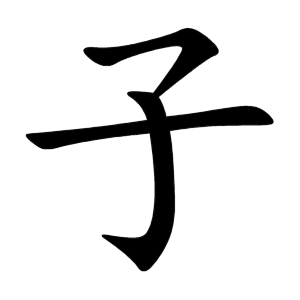子
- son;
- child, baby;
- male;
- person;
- you (second-person pronoun);
- fruit, seed;
Etymology
A pictograph modeled after the shape of a newborn baby.
Looking closely at the character, it shows a head, two arms stretched out to the sides, and legs.
Although it looks like it has only one leg, this is interpreted as representing a newborn who cannot yet stand on their own.
In oracle bone script, unlike the lines representing arms and legs, the head is drawn as a large loop to indicate the disproportionately large head of a baby compared to the body.
Starting as early as the Spring and Autumn period, or at least by the Han dynasty, 子 began to be used specifically to mean “son.”
Based on historical records, when used alone, 子 could mean:
• a descendant or person of a later generation,
• a son who continues the family line in a patrilineal society,
• or a respected member (usually male) of a family’s future generations, depending on the context.
Also, in names like Confucius (孔子) or Mencius (孟子), 子 is used as a respectful suffix meaning “master” or “teacher.”
Sometimes, 子 alone can refer to Confucius himself. In Confucian texts, the phrase 子曰 (zi yue) means “The Master said...”
Additionally, 子 was sometimes used in Classical Chinese as a second-person pronoun (you).
Usage in Korean
The character has various meanings, but the most common is to refer broadly to a child from infancy through youth.
A representative example is 女子 (woman, girl).
子 is also used as a diminutive or nominalizing suffix in words such as:
帽子 (hat)
椅子 (chair)
箱子 (box)
額子 (frame)
卓子 (table)
This suffix usually has no independent meaning but helps distinguish homophones. This kind of suffix is called 指小辭 (diminutive suffix).
Characters with 子
Words that derived from 子
- 공자(孔子)–Confucius
- 남자(男子)–man; male
- 남자 친구(男子親舊)–boyfriend
- 독자(獨子)–only son
- 부자(父子)–father and son
- 부자간(父子間)–father and son relationship
- 상자(箱子)–box
- 소립자(素粒子)–elementary particle; fundamental particle
- 소자(小子)–I; me
- 양자(養子)–adoptive son
- 여자(女子)–woman; girl
- 여자 친구(女子親舊)–girl friend
- 왕자(王子)–prince
- 원자(原子)–atom
- 자녀(子女)–child
- 자세히(仔細히/子細히)–in detail; minutely
- 자손(子孫)–sons and grandsons; posterity; offspring
- 자음(子音)–consonant
- 장자(長子)–eldest son
- 전자(電子)–electron
- 제자(弟子)–student
- 종자(種子)–seed; strain; breed; crowd
- 효자(孝子)–filial son; devoted son
- 弓木 (ND)
- ⿻ 了 一
